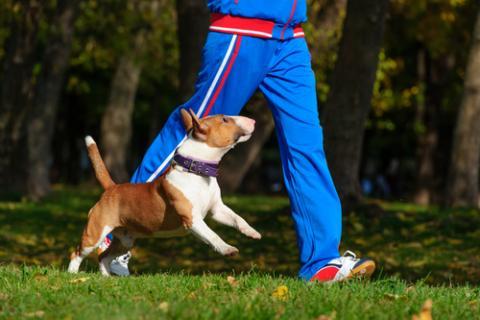
Running with your dog is one of the most rewarding ways to spend time together. Many runners dream of having a canine companion capable of running five, ten, or even 20 miles—a dog lean and strong, but also fast and nimble. Luckily, many dogs can make running partners. Knowing how to train your best friend, supplementing their diet with high-quality nutrients and supplements as necessary, and making decisions to keep both you and your dog safe can make all the difference between running that’s fun, and running that’s a drag for both of you.
Does breed matter?
While most dogs have the potential to be running partners, it’s important to realize your dog’s genetic limitations. Short-nosed breeds, which include pugs, chihuahuas, bulldogs, boxers, and shi tzus, may be susceptible to breathing issues that may make running long distances difficult, if not dangerous. Additionally, other breeds, like dachshunds, may not have the stature to support long distance running and may be better suited to short distances. The dogs listed below are generally seen as making the best running partners, though this is a suggestion and not a requirement by any means:
- Weimaraner
- Rhodesian Ridgeback
- Vizsla
- Border Collie
- Jack Russell Terrier
- Standard Poodle
- Dalmatian
- Australian Cattle Dog
- Belgian Malinois
- Doberman Pinscher
How do I start?
Just as humans need to build their endurance, so too do dogs. Always exercise caution when running with a puppy as their joints are still forming; doing too much too soon can result in orthopedic issues. Most veterinarians recommend beginning to run with your dog once he or she is past six months of age. From here, start with short bursts of running activity, interspersed with plenty of walking. As your dog ages, slowly incorporate higher mileage, aiming to run 3-4 times a week, 1-5 miles at a time depending on you and your dog’s fitness. Avoid being a weekend warrior with your dog—never curb your dog’s exercise to walks around the neighborhood during the week followed by all-day efforts on the trail on the weekend.
What should I feed my dog?
Most dogs are energetic animals capable of high levels of endurance. As canines, they’re meant to move. On days that my dog runs, I add more kibble to his mealtimes to ensure he is receiving adequate nutrition and calories. For longer days, packing a few digestible treats is a great option.
Grain-free, raw, or homemade dog food all tend to be high in nutrients, like omega-3 fatty acids. Supplementing with joint-aids like MSM can also be an option, especially as your dog ages. Before changing your dog’s diet or adding new supplements, consult with your veterinarian to learn what’s best for your dog.
What else should I consider during a run?
Temperature changes, seasons, and location can determine what you wear and how you act, so it makes sense that these variables affect your dog, too. Weather can have a big impact on your canine companion: high temperatures can cause heat stroke, often resulting in death, so it’s critical that you avoid running with your dog during the hottest part of the day. Depending on where you live, you might not be able to run with your dog during the summer.
Many online guidelines suggest that you avoid running your dog if the temperature and humidity are over 150. For example, 80° F with 80% percent humidity adds up to 160—well over safe conditions for your friend.
Other issues to consider include where you run. Roads and sidewalk can heat up fast, even on cooler days, and make the ground far too hot for your dog. Additionally, long miles on the road can be hard on your dog’s joints and paw pads. Consider opting for a trail run, especially one with shade. Always check your dog’s pads for sores before and after the run to avoid accidentally hurting your canine pal. Moisturizing and pet-friendly paw pad lotion is a great option.
Some dogs, like those with thick fur, are not suited to run in anything but cool or cold temperatures; likewise, those who have brachycephalic disease (the dogs discussed at the beginning of this article) have difficulty breathing and should not be running partners.
Lastly, it’s vital to always prioritize your dog’s health and safety above your own need to run. Dogs are loyal companion animals and don’t have the ability to tell you “no” when they’re tired, sore, overheating, or uninterested in running. Never force your dog to run with you and pay attention to signals that he or she should not be running, which include heavy panting and slowing down. Always provide plenty of water before, during, and after exercise and consider bringing a small first-aid kit in case anything happens on the run.








